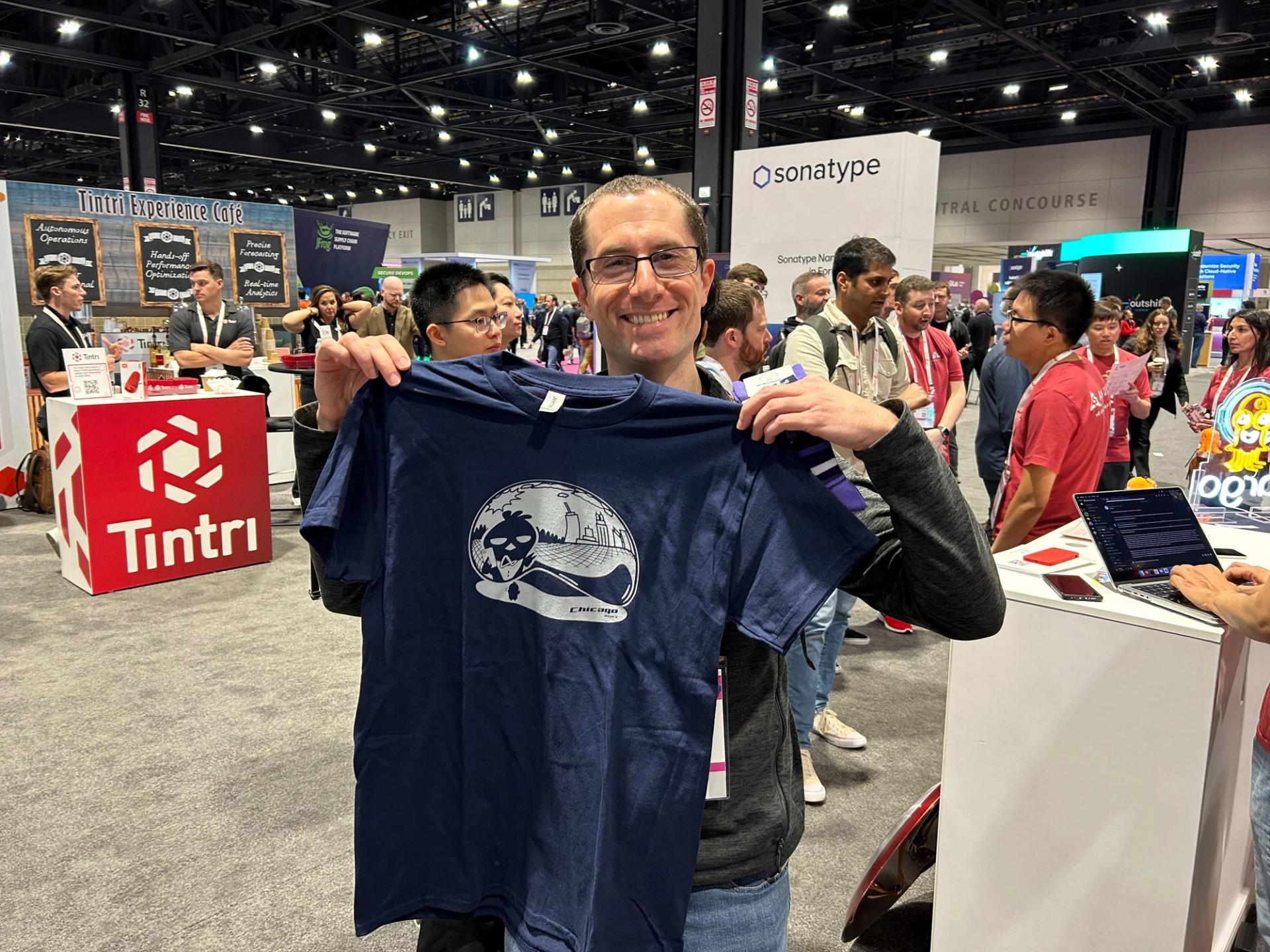The Ambassador team had a blast at KubeCon 2023 in Chicago this past week, and we were busy spotting the top trends that developers and tech professionals can expect more of in the new year. Here’s our list inspired by conference speakers, attendees, sponsors, and industry experts:
- The Buzziest: Platform Engineering, DevEx, Cloud Infrastructure, & AI
We can’t have a KubeCon conference without mentioning some of the biggest and buzziest themes of the year. Countless attendees brought up the increasing interest in platform engineering, improving Kubernetes developer experience specifically, and of course–the role that AI will play in the Kubernetes world moving forward.
The Buzz on Platform Engineering:
Platform Engineering has emerged as a pivotal trend in Kubernetes and cloud-native ecosystems, focusing on creating internal development platforms that act as bridges between traditional development and operations teams. Platform engineering is the practice of designing and building toolchains and workflows for self-service capabilities to reduce the complexity of software development. At KubeCon, there was a clear emphasis on how platform engineering facilitates smoother workflows, enabling developers to focus on writing code without being bogged down by infrastructure complexities.

As the role and function of platform engineering expands, we'll be primarily watching how it impacts these two important functions. The first, in smoothing out the initiation of development projects through a consistent and predictable set of tools (hence, 'platform’). And the second, in empowering developers with the proper internal developer platforms to test and deploy code without delays in their development lifecycle. Automated workflows will be where it's at!
- “What I want to have happen is finally solving the developer experience problem for Kubernetes. To improve it, many of us are capitalizing on the trend of platform engineering and that’s going to help a lot,” shared attendee Cornelia Davis of Spectro Cloud Inc.
- “WebAssembly has been buzzy and so has platform engineering as another topic people can't get enough of in our publication. A lot of stories have been on that. Those stories have been less so focused on the controversy of it replacing DevOps and more so on how it makes it better,” shared Andrew Tillery from the New Stack.

Dipping Our Toes Into AI & ML:
The integration of Artificial Intelligence (AI) and Machine Learning (ML) within Kubernetes environments is transforming how organizations handle complex workloads. Several areas of Kubernetes observability and management are particularly well-suited to AI and ML (Tech Target). Regardless of which you choose (AI or ML), experts advise to be cautious and start small. KubeCon showcased how Kubernetes is becoming an ideal platform for deploying and scaling AI/ML workloads.
Many of us are drawn to Kubernetes because of its dynamic nature which makes it an excellent choice for modern software architectures. However, the complexity and the intricate structure of many of today's cloud-native applications present obstacles to monitoring Kubernetes deployments, and that's an area where AI and ML technology are poised to vastly improve Kubernetes technology.
- “For trends for 2024, in my opinion, it’s all about AI and LLMs. I’m looking forward to seeing closer integration with the old world of Kubernetes and the new world of AI,” shared attendee and industry expert, Daniel Bryant.

More Cloud-Native Infrastructure:
According to Gartner, “over 95% of new digital workloads will be deployed on cloud-native platforms, up from 30% in 2021.” It’s no surprise that cloud-native is quickly becoming a de facto standard for software deployment models.
Cloud infrastructure's evolution was a hot topic at KubeCon, particularly focusing on how Kubernetes is being used to build more scalable and resilient systems. The discussions centered on Kubernetes' role in managing complex cloud environments, ensuring high availability, and facilitating seamless scaling.
There are also many benefits to cloud-native infrastructure. The first is to modernize legacy infrastructure, like virtual machines, which weren’t necessarily designed for the nuances of the cloud. With cloud-native platforms, workloads are better optimized to scale to new demands, helping to increase reliability and avoid outages. This optimization capability could be leveraged to maintain a leaner, more cost-effective IT footprint. Also, unlike waterfall, monolithic deployment modalities, cloud-native approaches enable more agility and a more frequent release cadence of microservices.
- “The biggest trend that we’re keeping an eye on is anything involved with cloud-native automation Infrastructure. We’re excited to be at Kubecon,” said attendee Steve Demchuk, CEO at Nitric.

2. Kubernetes Expansion (DUH!)
At this point, Kubernetes technology dominates 92% of the global market share for container orchestration tools used by businesses, according to the Cloud Native Computing Foundation. That was further made evident by DZone’s 2023 Kubernetes in their enterprise report. But now that we’ve reached critical mass and the late adopters have finally arrived, what will that mean for the experience of Kubernetes developers? Conversations have started to shift from “we should all be using Kubernetes,” to “now that we’re here, how do we ensure the development experience is positive, and do it in a way that scales?”

Now, it’s worth noting that this trend is more prevalent in large enterprises. According to the DZone report, the percentage of developers using Kubernetes and containers was only 71% for smaller organizations (less than 100 employees), versus larger organizations that reported closer to 91% Kubernetes usage.
- “A lot of our customers are using containers nowadays, the trend is that Kubernetes has really taken off past a point of no return! Check out the DZone’s latest trends report to see the figures. That’s why we’re here,” said product manager Bhavin Patel of Datadog.
- “A trend for 2024 that we’re trying to push is getting folks to actually run data on Kubernetes instead of managed services and building data directly right into the Kubernetes now that so many people are utilizing Kubernetes,” said Eric Shank of Portworx.

3. Cost Management is Still a High Priority
After massive layoffs and cutbacks by many tech companies in 2022 and 2023, the tech industry is still recovering and you can see that cost management is still a huge priority for many conference attendees. Figuring out how to do more with less and still innovate to meet expectations has been weighing on many looking ahead to 2024.
Many CIOs and team leaders are still reducing costs where possible out of anticipation of a potential recession looming. Enhancing the visibility of both the holistic cost and ROI of developer tools upfront can help entice would-be buyers into still making necessary purchases.

- “For trends for the new year, I hear a lot of folks talking about inter-availability zone costs, and we are looking at doing the same internally as well. Wherever we can save, we’re doing it,” said attendee Jason Morgan, community advocate at Buoyant.

- “Cost optimization is a huge trend for us. And with that, looking at the actual density of workloads, and the isolation between different workloads. That’s what we’re focused on moving into 2024,” shared conference attendees and engineers Andrea and James.

- “Going into 2024 Kubernetes trends, the service mesh is big for us. Also, continuing to grow is important while having cost observability and understanding alternatives in that space are big things we’re looking at for the new year,” shared attendees Bailey Jensen and Martin Olsen, teammates from Workiva.
4. Bring on the WebAssembly
We noticed an increasing interest in WebAssembly (WASM), at KubeCon this year, even more so than what we saw earlier in the year at KubeCon EU. WebAssembly is a binary instruction format that serves as a portable compilation target for high-level programming languages like C, C++, and Rust. WASM is rapidly becoming a game-changer in the Kubernetes ecosystem as developers look to build secure and fast-running modules that can be executed almost anywhere including Kubernetes clusters. Initially, the appeal of WASM was due to the promised performance gains and greater portability for web applications.More recently, its potential to impact across a growing number of environments has spread.
- “For 2024, our big thing is all about WebAssembly and its component model. We’re hoping it will help us simplify complex applications,” said attendees and engineers from the JAFLabs.
- “It’s Web assembly all the way, this is the year. It's just waiting for critical mass for it to be a thing, I expect it will take off in 2024,” said an attendee and a Dev Team member at MyFitnessPal.

5. Increased Security (Yes, Even More!)
Cybercrime as a whole is expected to cost companies worldwide an estimated $10.5 trillion annually by 2025, up from $3 trillion in 2015 (Embroker), and for those who deal with APIs, over 94% of developers had some security issue with their production APIs over the past year (Salt Security). Needless to say, everyone is doubling down and investing in better security practices. Speaking of which (shameless plug alert!), if you’re looking for an API Gateway to improve your API security practices–look no further than Edge Stack.
We’ve noticed a particular uptick in Zero Trust security models, which is an approach rooted in the principle of treating users, systems, and network traffic as fundamentally untrusted even though they are within the security perimeter established by a firewall. You may be familiar with the perimeter security model which states you can trust anyone and anything inside the network. Well, turn that on its head. Zero trust says to make no assumptions about and explicitly check each individual and interaction. With the global rise of remote work, zero trust security approaches have taken off in popularity!
- “Looking ahead to 2024, we’re most concerned with Kubernetes security. Zero trust clusters are going to continue to be very important,” shared conference sponsor David Simmons from Otterize.
- “For the new year, we’re looking to expand our goal of being a safe source for open source and increasing security measures, because that will only continue to grow!” shared conference sponsors from the Chainguard developer team.
6. Grab Bag: Other Things We’re Keeping an Eye On
There were many other trends and topics mentioned at KubeCon, but we can’t cover them all! These were the few other niche topics that attendees expressed interest in.
- “For the new year, we’re looking forward to some automated right-sizing, for years many developers have been doing resource requests manually and it’s time to move past that,” said sponsor Andy Sunderman of the Fairwinds team.

- “For 2024, we’re excited for our open-source project, Kargo. At first, Kubernetes came out, then , & then Argo, but NOW it’s all about ‘how do I do the rest of what I need to do in GitOps?’ -That’s where Kargo comes in” shared sponsor Daniel of the Akuity team.

- “Maybe next year, I’d love it if someone would make stateful workloads easier, or if it was easier to integrate custom metrics with HPAs because it's truly such a pain,” shared conference sponsors from the Honeycomb team.
- “The trends we’re noticing include tag sustainability & right-sizing our VMs. There was a keynote that we loved on scalability for the environment. We’re also big Dapper fans, it makes it easy to work with distributed systems,” said KubeCon attendee Mark Cupito and friends.

- “I think the cooperative multi-cluster is going to be a big 2024 trend as folks figure out that they can use that instead of name spaces to isolate things. Also, people need to realize the application developer is THE most important role in the system, let’s start prioritizing those folks!” shared Flynn, tech evangelist from Buoyant.

